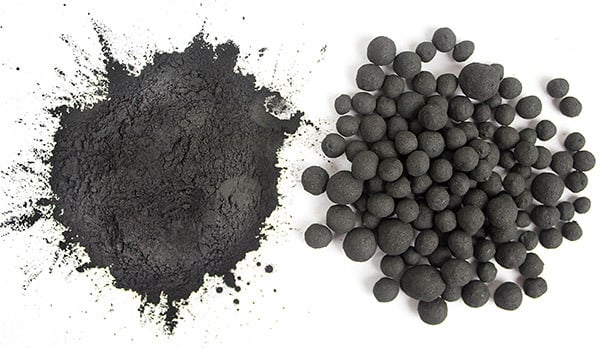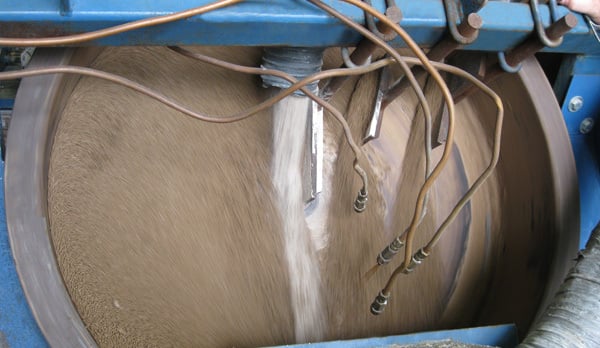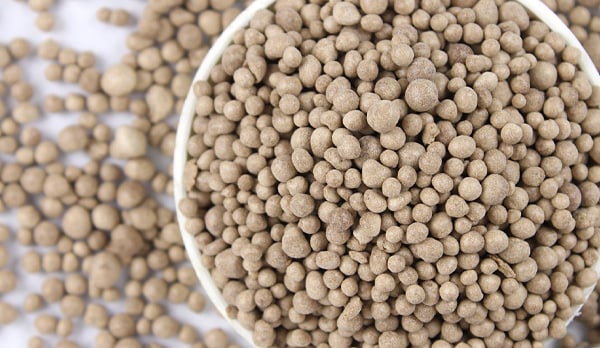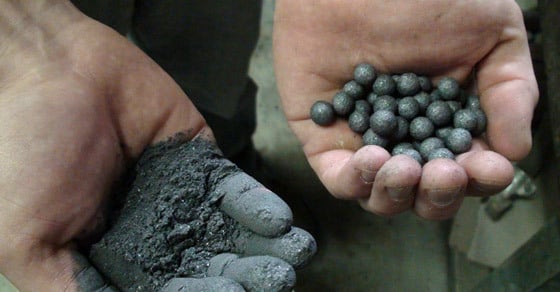Pelletizing is a type of agitation agglomeration used across industries to convert fine powder materials into granular products. The practice offers a number of benefits, and as a result, continues to be employed in a growing number of applications ranging from minerals to specialty chemicals.
This, combined with the fact that each material responds in a unique way to the pelletizing process, has given rise to questions around the technique. The following provides an overview on how, and why, to pelletize a fine powder.
Why Pelletize Fine Powder?
Anyone working with bulk solids in the form of a fine powder can attest to the numerous challenges it can present. Through pelletizing, however, these challenges can be transformed into benefits, including:
Cleaner Handling & Flowability
Round granules are inherently more flowable than powder, allowing for more precise metering and dosing of material. Pellets are also substantially less dusty than powder, so fugitive material escaping as dust is significantly reduced, resulting in a cleaner facility. This absence of dust is especially noticeable at drop and transfer points, which were previously major sources of fugitive material and housekeeping issues.
Reduced Material Loss
Also as a result of the reduced dust, significantly less material is lost as fugitive material.
More Economic Shipping
Pelletizing sometimes allows producers to pack more material into the same amount of space. In turn, this can improve shipping economics by reducing the number of loads needed, making shipping more efficient.
Better Control Over Particle Characteristics
Pelletizing also gives producers more control over their product, including how it looks, handles, and acts. This is beneficial for a number of reasons, including performance in end-use applications, behavior as an intermediate material in downstream processing, active ingredient delivery, prevention of segregation, storage characteristics, and more.

The raw (left) and pelletized (right) coal sample above illustrates the much cleaner handling and control over particle characteristics that pelletizing can offer to fine powders.
The Process of Pelletizing a Fine Powder
The challenge with pelletizing any fine powder is that all materials, and even the same material from different sources or deposits, respond uniquely to pelletizing, owing to variations in chemical composition and physical characteristics.
The process also differs based on the end-product goals, adding another layer of complexity. A common approach to pelletizing powder is outlined here.
Preparing to Pelletize a Fine Powder
The effectiveness of the pelletizing process is greatly influenced by the material’s starting characteristics as a feedstock. In some cases, this may require some level of pretreatment to bring the material into the optimal range of specifications for pelletizing.
Most importantly, the fine powder must typically fall within a specific particle size distribution (PSD) and moisture content. The optimum range for each parameter is specific to the material being processed and is often identified through testing.
A material that does not meet PSD and/or moisture requirements may necessitate drying and/or crushing prior to the pelletizing process.
Feedstock should be processed to be as uniform as possible (though a slight variance in PSD is encouraged to produce a strong pellet product).

Pretreated fine powder ready for pelletizing
Step One: Precondition the Fine Powder
Once the feedstock meets moisture and size requirements, it is ready for the pelletizing process.
The first step in most pelletizing lines is a preconditioning step. Preconditioning in this case refers to mixing the powdered feed with the chosen liquid binder (and any other additives) to produce a homogeneous feedstock for granule formation.
Were a preconditioning step not put in place, the solid and liquid feed components would not be homogeneously combined, which could lead to challenges in granule formation, uneven distribution of binder, a lack of uniformity in product crush strength, and more.
In most cases, the preconditioning device, typically a pin mixer, is also used to form seed pellets, or nuclei, for further layering in the subsequent agglomeration device. Preconditioning ultimately provides the agglomeration unit with a uniform feedstock of starting seed pellets onto which layers of material can then be added.
Step Two: Grow and Refine Pellets
Once the material has been preconditioned and seed pellets have formed, the feedstock can be fed onto the disc pelletizer (also known as a pan granulator).
The seed pellets, along with additional binder, are continuously fed onto the rotating disc. During this time, it is critical to pay attention to upstream processing conditions, as any change in the production line preceding the disc will likely impact the material on the disc pelletizer and may require an adjustment.
Using Disc Pelletizer Variables to Make Adjustments
The following variables can be adjusted in real time to increase on-size product yield, encourage or discourage more agglomeration, and refine product characteristics:
- Binder spray rate and spray locations
- Feed rate and location
- Disc speed
- Disc angle
- Plow/scraper positioning
The adjustment of one variable often affects the other variables and therefore must be carried out systematically to avoid affecting the product in undesirable ways or causing a process upset. Disc speed and angle are typically adjusted together, as they are closely related. FEECO recommends disc pelletizer training for all operators to provide them with a foundational understanding of agitation agglomeration and the principles behind their unique pelletizing process.

The pelletizing process on a disc pelletizer
Step Three: Dry Wet Pellets
Once pellets reach the desired size, they are automatically ejected from the disc pelletizer via centrifugal force. From here, they are carried via conveyor or bucket elevator to the dryer. Not all operations require a drying step; in some cases the pellets will be fed directly to a rotary kiln for heat treatment. In most cases, however, pellets must be dried.
Pellets exiting the disc pelletizer are in their “green” or wet state. Were they not dried, they would not hold their final form and could invite problems such as mold growth, caking, higher shipping costs, and product degradation.
Drying is typically best carried out in a rotary dryer, as the tumbling action imparted by the rotating drum helps to polish granules. Rotary dryers employ material lifters, or flights to pick up the material and drop it through the process gas in a cascading motion (for this reason they are also sometimes referred to as a cascade dryer) that helps to maximize heat transfer efficiency.
After drying, the finished pellets are typically screened into overs, unders, and on-size. Overs are crushed down and combined with the unders to create a recycle stream that feeds back to the pin mixer.

Dried, finished pellets
Variations on Pelletizing Fine Powder
The process described above is the most common approach to pelletizing a fine powder. However, it is far from the only one. In fact, the pelletizing technique is such that different pieces of equipment or changes in process variables may produce better (or worse) results, depending on the specific product goals and the characteristics of the feedstock.
In some cases, the omission of the disc pelletizer, leaving the pin mixer as the sole agglomeration device, may produce the desired results. In other cases, a pugmill mixer may provide sufficient agglomeration.
Similarly, a rotary drum agglomerator may be used as the sole agglomeration device, or even combined with a mixer to yield the desired-quality product. It is not uncommon for operations to utilize a rotary drum in place of a disc pelletizer to achieve a higher capacity.
Test the Process to Pelletize Fine Powder
The different types and combinations of equipment, paired with the various binders, product goals, and feedstock behaviors makes testing a key step in the development of a successful pelletizing line.
Batch tests at facilities such as the FEECO Innovation Center provide a window into the feasibility of an intended powder pelletizing operation, and may also help to guide equipment and binder selection. In the Innovation Center, successful batch tests can then be trialed on a larger pilot and even continuous scale in order to gather the process data necessary for commercial scale-up.
This type of testing de-risks the path to commercialization and helps to streamline the process of reaching rated capacity upon start-up, as it identifies potential issues early in the process.
Work With A Fine Powder Pelletizing Expert
Between testing, identifying the right equipment, optimizing the process, acquiring the equipment, and getting through start-up, producers looking to pelletize a powder feed are faced with an undeniably challenging task.
By working with an agglomeration expert, producers can minimize the amount of friction they encounter during this process, as the expert helps to guide them through the steps and the many decisions along the way.
FEECO is a global leader in agitation agglomeration/pelletizing equipment and systems, with expertise in process testing and development, custom equipment design and manufacturing, and parts and service support. For more information on pelletizing fine powders, or to see if pelletizing could solve your powder problem, contact us today!



